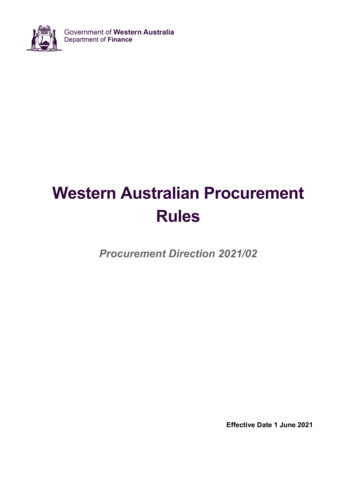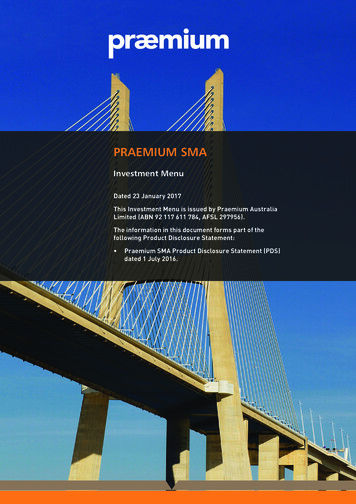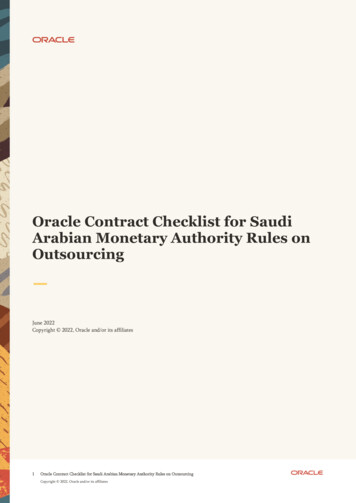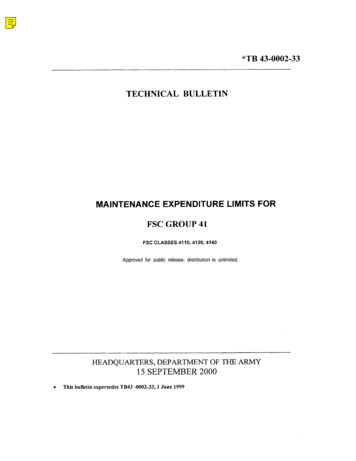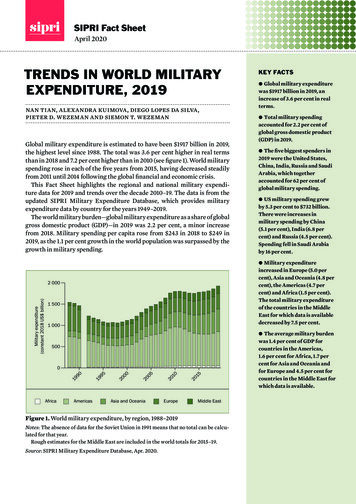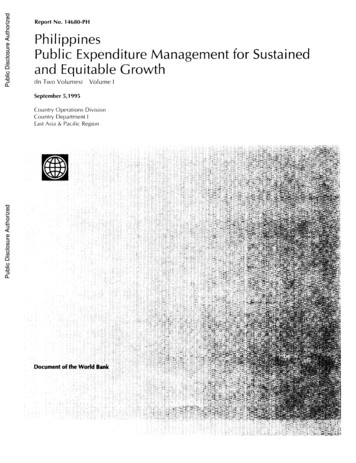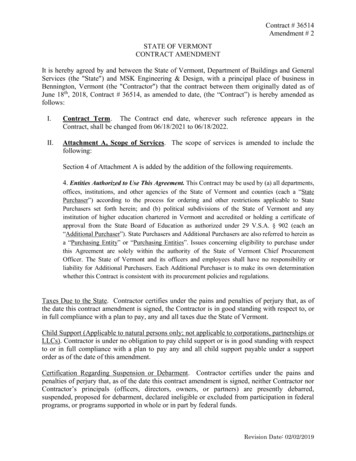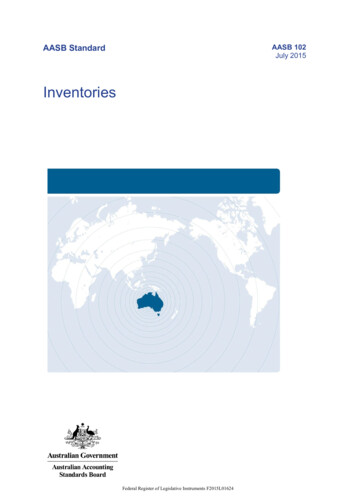
Transcription
OFFICIALAustralian Contract ExpenditureMeasurement RulesVersion 1.1OFFICIAL
OFFICIALCopyrightCommonwealth of Australia 2021With the exception of the Commonwealth Coat of Arms, this publication is providedunder a Creative Commons Attribution-NonCommercial 4.0 International Licence 1.This publication should be attributed as Australian Contract Expenditure Measurement Rules.Use of the Coat of ArmsThe terms under which the Coat of Arms can be used are detailed on the Department of the PrimeMinister and Cabinet website 2.FeedbackAll feedback on this publication and suggestions for improvement should be sent to:procurement.ASDEFCON@defence.gov.au.AMENDMENT LISTVersion NumberUpdatesRelease DateVersion 1.0Initial Release25 August 2021Version 1.1Update to Supplies, plant,equipment, tools and vehiclescost category for Services forrelease of ASDEFCON(Support) v5.05 October coat-armsOFFICIAL
OFFICIALINTRODUCTIONThese Australian Contract Expenditure (ACE) Measurement Rules have been developed to standardisethe way in which Australian Contract Expenditure is measured across Defence procurements. Therules provide confidence to potential suppliers that they are competing on a level playing field whenmaking commitments to include Australian and New Zealand businesses in their supply chains andfacilitate Australian Contract Expenditure being measured and reported consistently across Defencecontracts.The rules form part of Defence’s Australian Industry Capability Program and support Defence industrypolicies including the 2019 Defence Policy for Industry Participation. They promote the AustralianGovernment’s commitment to building a stronger, more prosperous and resilient economy whereAustralian businesses can be competitive on a domestic and international level.By adopting these standardised rules, Defence can ensure that suppliers are treated equitably whenassessing Australian Contract Expenditure proposals under tender responses.The rules are relevant to:a.tender preparation enabling tenderers to calculate Australian Contract Expenditure and thePrescribed ACE Percentage for each ACE Measurement Point (where applicable) to besubmitted as part of a tender;b.preparation of Contract Change Proposals (CCPs) when assessing and updating thePrescribed ACE Percentage in respect of each ACE Measurement Point (where applicable);c.calculating the Achieved ACE Percentage at each ACE Measurement Point to determinewhether the Contractor has achieved the Prescribed ACE Percentage in respect of each ACEMeasurement Point (where applicable); andd.conducting audits to ensure compliance with the Contractor’s AIC Obligations.Other than those terms that are defined within this document, defined terms used are defined inaccordance with the Australian Standard for Defence Contracting (ASDEFCON) suite of tendering andcontracting templates.ACE Measurement Rules (V1.1)OFFICIAL1
OFFICIALACE MEASUREMENT RULES1.CALCULATION OF AUSTRALIAN CONTRACT EXPENDITURE AND IMPORTEDCONTRACT EXPENDITURE1.1Australian Contract Expenditure (ACE) and Imported Contract Expenditure (ICE) shall becalculated subject to the following:a.the general principles in paragraph 2;b.the deeming provisions in paragraphs 3 and 4; andc.the principles applicable to specific cost categories in paragraph 5.2.GENERAL PRINCIPLES2.1ACE and ICE shall be calculated in accordance with the following principles:a.(Method of calculation): ACE and ICE shall be calculated separately for theContractor and each Subcontractor, against elements of the Contract WorkBreakdown Structure, and then aggregated to determine the overall ACE and ICEfor the Contract.b.(Amounts to be expressed in AUD): To the extent that amounts comprising ACEor ICE are not expressed in AUD, such amounts shall be converted into AUD usingthe applicable Base Date Currency Exchange Rate.c.(Amounts to be expressed in Base Date dollars): Amounts comprising ACE orICE shall be de-escalated applying the indices within the applicable Annex toAttachment B so that they are expressed in Base Date dollars.d.(Currency not determinative): The currency in which payments are made to theContractor or to a Subcontractor will not be determinative of whether the costsassociated with those payments are ACE or ICE.e.(No double counting): There will be no double counting of costs or profit. Anamount cannot be included as both ACE and ICE.f.(Deeming of Imported Contract Expenditure): If there is a conflict in theapplication of these ACE Measurement Rules in relation to whether an amount isACE or ICE, such amount will be deemed to be ICE.g.(Amounts exclusive of GST): All amounts included in the calculation of ACE (otherthan in respect of paragraph 2.2d) or ICE (other than in respect of paragraph 2.3d)will be exclusive of GST and equivalent overseas consumption taxes.Note: ACE is calculated by aggregating costs which comprise ACE for the Contractor and eachSubcontractor individually (ie, in calculating the Contractor’s ACE, any Subcontractor ACE isexcluded. In calculating a Subcontractor’s ACE, any sub-Subcontractor’s ACE is excluded andso on.). The Contractor’s and each Subcontractor’s ACE is then aggregated to determine totalACE. A similar approach is adopted for ICE.2.2Australian Contract Expenditure means the sum of:a.direct costs incurred by:(i)the Contractor (other than amounts paid by the Contractor to Subcontractors);or(ii)a Subcontractor (other than amounts paid by the Subcontractor to otherSubcontractors),to the extent those costs are incurred by an Australian Entity in performing workunder the Contract or a Subcontract (as applicable) in Australia or New Zealand;b.subject to paragraph 4, indirect costs (including overhead and general andadministration costs) incurred and appropriately allocated to the Contract orSubcontract (as applicable) to the extent that work performed in providing goods orservices to the Contractor or Subcontractor (as applicable) in respect of suchACE Measurement Rules (V1.1)OFFICIAL2
OFFICIALindirect costs (including overhead and general and administration costs) wasperformed by an Australian Entity in Australia or New Zealand;c.amounts paid by:(i)the Commonwealth to the Contractor;(ii)the Contractor to a Subcontractor; or(iii)a Subcontractor to another Subcontractor,in respect of:(iv)budgeted costs which are not utilised by the Contractor or Subcontractor (asapplicable);(v)management reserve, contingencies, estimating uncertainty or similaramounts to the extent not utilised and expended by the Contractor orSubcontractor (as applicable);(vi)incentive or similar payments; and(vii)profit,where the recipient of such payment (ie, the Contractor or Subcontractor (asapplicable)) is an Australian Entity; andd.2.3GST and taxes equivalent to GST in New Zealand paid by the Commonwealth tothe Contractor.Imported Contract Expenditure means the sum of:a.direct costs incurred by:(i)the Contractor (other than amounts paid by the Contractor to Subcontractors);or(ii)a Subcontractor (other than amounts paid by the Subcontractor to otherSubcontractors),(as applicable) to the extent those costs are incurred in performing work under theContract or a Subcontract (as applicable) other than in Australia or New Zealand;b.subject to paragraph 4, indirect costs (including overhead and general andadministration costs) incurred and appropriately allocated to the Contract orSubcontract (as applicable) to the extent that work performed in providing goods orservices to the Contractor or Subcontractor (as applicable) in respect of suchindirect costs (including overhead and general and administration costs) was notperformed by an Australian Entity in Australia or New Zealand;c.amounts paid by:(i)the Commonwealth to the Contractor;(ii)the Contractor to a Subcontractor; or(iii)a Subcontractor to another Subcontractor,in respect of:(iv)budgeted costs which are not utilised by the Contractor or Subcontractor (asapplicable);(v)management reserve, contingencies, estimating uncertainty or similaramounts to the extent not utilised and expended by the Contractor orSubcontractor (as applicable);(vi)incentive or similar payments; and(vii)profit,where the recipient of such payment (ie, the Contractor or Subcontractor (asapplicable)) is not an Australian Entity; andACE Measurement Rules (V1.1)OFFICIAL3
OFFICIALd.overseas taxes equivalent to GST (other than taxes equivalent to GST in NewZealand) paid by the Commonwealth to the Contractor.2.4A reference to “performing work” or “work performed” in paragraphs 2.2 and 2.3 is areference to performing any work under the Contract or Subcontract (as applicable)including performing any obligations under the Contract or Subcontract (as applicable) andany work associated with the provision of the Supplies or Services (as applicable).3.DEEMING FOR CERTAIN SUBCONTRACTS3.1Amounts paid by the Contractor or a Subcontractor to Subcontractors which are anAustralian Entity where the aggregate value of the Subcontract is less than the applicablethreshold specified in the table below will be deemed to have the ACE and ICE specifiedin the table below unless the actual ACE is greater than the deemed amount as calculatedin accordance with paragraph 2.2 in which case the Contractor may elect to rely on theactual ACE subject to the Contractor complying with paragraph 3.3:Substantial Nature ofSubcontractor workApplicableThreshold (GSTexclusive)Deemed Australian ContractExpenditure and Imported portedContractExpenditureSupply of ICT equipment 1,000,00020%80%Supply of Software 1,000,00020%80%Supply of Consumables(other than bulk fuels) 1,000,00040%60%Provision of utilities 1,000,000100%0%Provision oflabour/professional services(eg, legal, accounting,consultancy, engineering,project management andadvisory services) 1,000,000100%0%Other Subcontracts notreferred to above 1,000,00050%50%3.2Where there is more than one Subcontract with the same Subcontractor, the aggregatevalue of each of those Subcontracts shall be used for the purposes of assessing whetherthe monetary threshold for the purposes of paragraph 3.1 has been met.3.3Where paragraph 3.1 applies in respect of a Subcontract and the Contractor elects to relyon the actual ACE, the Contractor shall, on request by the Commonwealth, demonstrateto the Commonwealth that the ACE in respect of relevant Subcontract is greater than theamount deemed in accordance with paragraph 3.1.3.4A Contract to which these ACE Measurement Rules apply may specify additional oralternative Subcontract categories, thresholds and deemed ACE and ICE for the purposesof the application of this paragraph 3 provided that the applicable threshold in relation toany additional or alternative Subcontract categories shall not exceed 4 million (GSTexclusive).ACE Measurement Rules (V1.1)OFFICIAL4
OFFICIAL4.DEEMING FOR INDIRECT COSTS (INCLUDING OVERHEAD AND GENERAL ANDADMINISTRATION COSTS)4.1Subject to paragraphs 4.2 and 4.3, where indirect costs (including overhead and generaland administration costs) are incurred and appropriately allocated to the Contract orSubcontract (as applicable) by an Australian Entity, such costs will be deemed to be:4.24.3a.70% ACE; andb.30% ICE.Subject to paragraph 4.3, where indirect costs (including overhead and general andadministration costs) are incurred and appropriately allocated to a Subcontract by anAustralian Entity which, together with any Related Bodies Corporate, has fewer than 200full-time equivalent employees, such costs will be deemed to be:a.85% ACE; andb.15% ICE.Where:a.the Commonwealth (through Financial Investigation Service (FIS)) has formallyapproved in writing a deemed ACE percentage and a deemed ICE percentage inrespect of indirect costs (including overhead and general and administration costs)for the Contractor or a Subcontractor; andb.the deemed ACE percentage and ICE percentage in respect of the Contractor orSubcontractor (as applicable) is specified in the Contract,any indirect costs (including overhead and general and administration costs) incurred andappropriately allocated to the Contract or Subcontract (as applicable) will be deemed tocomprise ACE and ICE (as applicable) in accordance with the Commonwealth’s approval.4.4The deemed outcomes in accordance with this paragraph 4 apply regardless of how theindirect costs (including overhead and general and administration costs) are recovered bythe Contractor or Subcontractor (as applicable). For example, the deemed outcomes inaccordance with this paragraph 4 apply to the extent that such costs are recovered as partof labour rates.5.PRINCIPLES APPLICABLE TO SPECIFIC COST CATEGORIES5.1Subject to the application of paragraphs 3 and 4, ACE and ICE shall be calculated inaccordance with the following principles:Cost categorySalary and wages(including direct oncosts includingsuperannuation),bonuses andredundanciesSpecific ruleAmounts incurred by the Contractor or a Subcontractor for salary andwages (including direct on costs including superannuation), bonuses andredundancies for officers and employees (excluding any indirect costs):a. will be ACE where the employees or officers are:(i) employed by an Australian Entity where the relevant employees andofficers are performing work in Australia or New Zealand;(ii) employed by an Australian Entity where the relevant employees andofficers are temporarily performing work outside of Australia or NewZealand for the purpose of transferring skills or technology toAustralia; or(iii) employed by a non-Australian Entity where the relevant employeesand officers are performing work in Australia or New Zealand for aperiod in excess of six (6) continuous months for the purpose oftransferring skills or technology to Australia; orb. will otherwise be ICE.ACE Measurement Rules (V1.1)OFFICIAL5
OFFICIALCost categorySpecific ruleTravelAmounts incurred by the Contractor or a Subcontractor for meals,allowances and accommodation:a. will be ACE where the amounts incurred relate to travel within Australiaor New Zealand; orb. otherwise will be ICE.Amounts incurred by the Contractor or a Subcontractor for air travel:a. will be ACE where the travel is within Australia or New Zealand orbetween Australia and New Zealand and the airline is an AustralianEntity; andb. subject to paragraph a, will be deemed to be 30% ACE and 70% ICEwhere the flight originates or terminates in Australia or New Zealand; orc. will otherwise be ICE.Lease of plant,equipment, tools,vehiclesAmounts incurred by the Contractor or a Subcontractor as rent for plant,equipment, tools or vehicles (whether under an operating lease or afinancing lease):a. will be ACE to the extent that:(i) the capital cost of acquiring the plant, equipment, tools and vehicleswould otherwise be ACE under these ACE Measurement Rules;(ii) interest and borrowing expenses would otherwise be ACE underthese ACE Measurement Rules; and(iii) other costs (such as establishment costs) would otherwise be ACEunder these ACE Measurement Rules; orb. will otherwise be ICE.Lease of facilitiesAmounts incurred by the Contractor or a Subcontractor as rent for facilities:a. will be ACE to the extent that the facilities are located in Australia or NewZealand; andb. will otherwise be ICE.Supplies, plant,equipment, tools andvehicles used inconnection with theprovision of theSupplies or ServicesTo the extent that the Supplies, plant, equipment, tools and vehicles usedin connection with the provision of the Supplies or Services comprisephysical products, equipment, hardware, software, materials, parts orcomponents and such items would otherwise be ICE (whether in whole orin part) under these ACE Mea
ACE Measurement Rules (V1.1) 1 . OFFICIAL INTRODUCTION . These Australian Contract Expenditure ( ACE) Measurement Rules have been developed to standardise the way in which Australian Contract Expenditure is measured across Defence procurements. The rules provide confidence to potential suppliers that they are competing on a level playing field when
